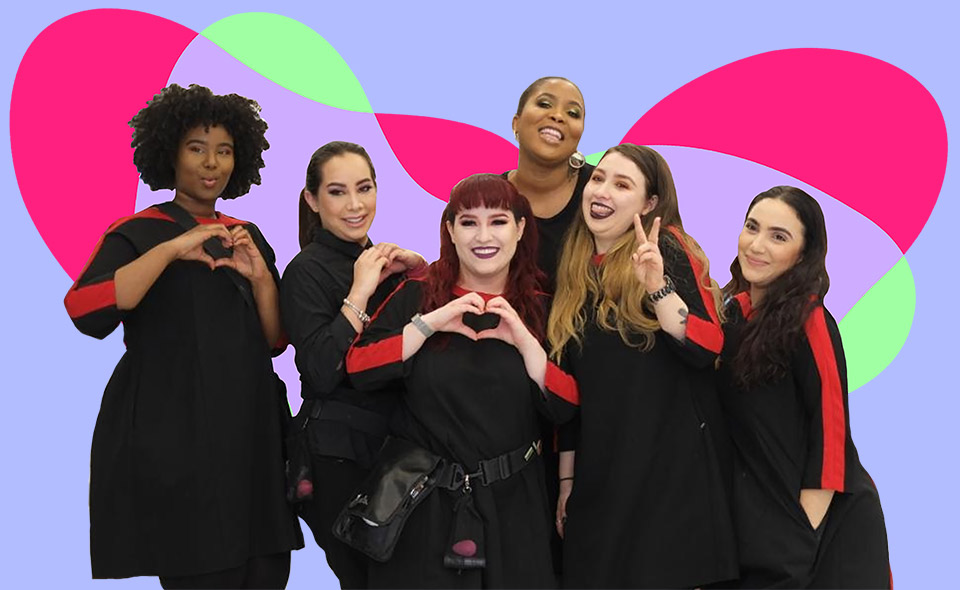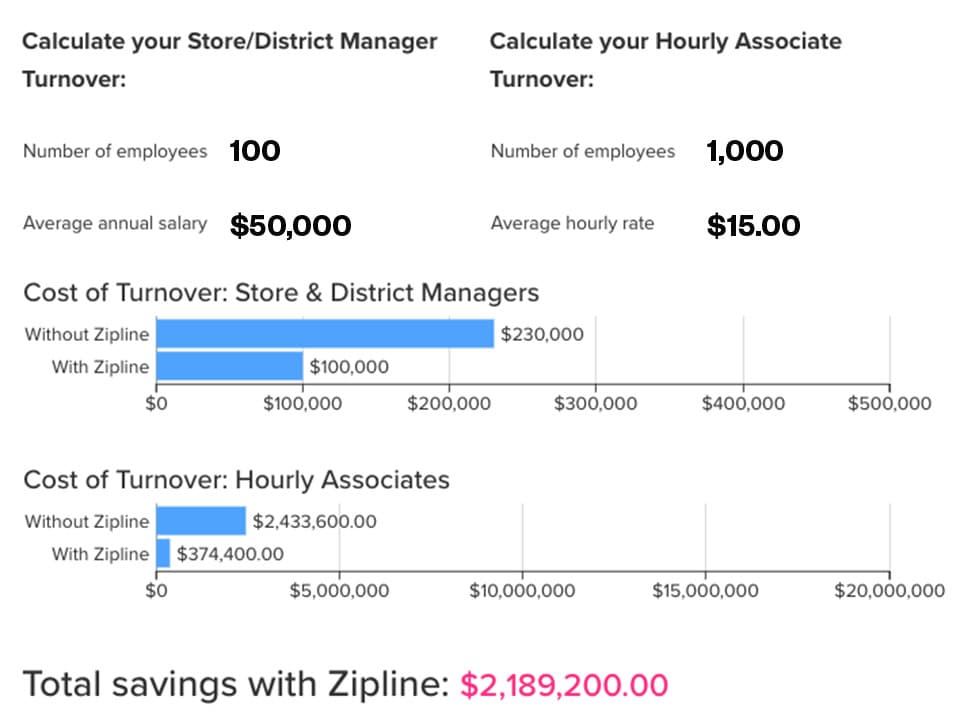"Your biggest challenge
isn't technology, innovation,
or even leadership.
It’s finding,
hiring and engaging
the right talent
to thrive now
and in the future.
Make constant reset
your friend. Upheaval
brings about opportunities
to rethink, reset,
and restructure
your organization."
- Johnny C. Taylor,
President and CEO of SHRM
In the wake of the Covid-19 pandemic, retail employees are demanding more flexible and fulfilling work, better wages and benefits, and a higher standard of workplace safety. It’s why everywhere you look workers across every industry - from tech to healthcare to manufacturing and more - are giving their two-weeks notice.
Among the hardest hit by this mass employee exodus is the retail industry. The Washington Post reported that almost 650,000 retail workers put in their notice in April 2021 alone, and called it “the industry’s largest one-month exodus since the Labor Department began tracking such data more than 20 years ago.” In Zipline’s Labor of Love Report, we discovered that 42% of retail associates are considering or have already decided they are planning to leave the retail workforce after the pandemic.
Whether you call it the or the “Great Resignation,” one thing’s for certain: this is a time of reckoning for HR leaders. Retailers that want to take advantage of a volatile labor market will need to step up their recruitment efforts. Those that want to hold on to their people will need to develop better experiences for current employees.
That’s why we’ve pulled together this comprehensive guide: To help our retail friends navigate the HR strategy building process and set their teams up for success in a post-Covid reality. Here you’ll find statistics, trend analysis, case studies, and tactics to combat turnover and differentiate your brand in an increasingly competitive marketplace.
Ready to dive in? Let’s get started.


A retailer’s CHRO (or similar HR executive) function is unique in that it usually spans oversight of two very different worlds: Headquarters and Stores. This means a retail HR executive needs to simultaneously balance the needs of an employee population that’s historically been co-located and office-based with the needs of another employee population that is completely distributed.
It’s important to emphasize just how different the retail headquarters employee experience is from the retail store employee experience. Store teams don’t sit at a desk all day reading emails, they don’t have access to the same amenities, and they may go days (or even weeks) without an in-person meeting with their boss. It then makes sense that a strategy that tackles the problems of retention and engagement among field employees would look different than a strategy with similar goals at HQ.
The recent shift to remote work (across all industries) has placed much of the focus on employee experience firmly onto headquarters-based employees. HR leaders are now tasked with preserving company culture as HQ employees work remotely, rolling out hybrid workforce models, and evolving their company value proposition accordingly. All of these important and necessary tasks can cause field-based employees’ needs to fall by the wayside.
So, why focus on improving the employee experience in stores? Simply put: because the financial benefits are staggering. Recently, World at Work broke down turnover in retail at a more specific level, and the numbers are eye-opening:
The cost of that turnover varies, too. For associate level positions, employers can expect to pay 16% of an annual salary to replace a worker. (that means for an associate who makes $10 an hour, it would cost around $3,328 to replace them). It costs around 20% of an annual salary to replace a store manager. The higher the turnover rate, the more a business’s bottom line is impacted.
Do the math, and it’s easy to see why addressing engagement and retention areas among your store employee population should be a key part of your business strategy.
As HR leaders stand at the precipice of a massive shift in employee demands, it can help to look at the current macro trends in retail and ask yourself how your brand plans to address them:

Covid-19 changed shopping habits for good: more curbside pick-up, more 2-hour delivery, more online orders. Those habits are sticking around even as more of the population becomes vaccinated and cases subside, which means retail is fundamentally changing. Employment in warehouse and transportation industries is booming, and companies like Amazon are stepping up efforts to attract top talent.
Is your company committed to addressing the new realities of the retail talent market head-on? Are your key stakeholders aware of these macro issues and open to rethinking their tried-and-true (but no longer relevant) strategies when it comes to hiring and retaining top talent?
While the average employee turnover for all U.S. industries is around 19 percent, the average turnover rate in the retail industry is just above 60 percent, according to the National Retail Federation. Long shifts, low pay, poor onboarding, and mismanagement all contribute to this metric, but many workers also cite the fact that feeling “disconnected to HQ’s vision and plan” is ultimately a factor in their decision to leave a company.
The pandemic brought the struggles of part-time, frontline retail workers to light. Many struggled to balance grueling health and safety protocols and difficult customer interactions with inconsistent schedules and low pay - and it’s not getting any easier.
In a tight labor market, telling prospective employees how they can benefit from working for you can be the difference between fully staffed stores and scrambling to cover shifts.
Most organizations today differentiate themselves from competitors with an Employee Value Proposition. This is the sum of your company’s values, commitment to customers, and how you compensate, retain and develop those who work for you. Now more than ever, other aspects of a company’s culture - such as their stance on mental health or commitment to social responsibility - are critical parts of this value proposition, too.
It’s easy to feel nervous when competitors like Amazon are offering eye-popping hiring bonuses and sky-high starting wages. How are traditional brick-and-mortar retailers to compete? But it’s not so simple. In fact, when it comes to Gen Z and Millennial hires, studies show that purpose beats pay.
For example, in CONE Communications’ Millennial Employee Engagement Study, 64% of millennials said that they wouldn’t take a job at a company that wasn’t socially responsible. Similarly, three quarters said that they’d take a smaller salary to work at a company more in alignment with their values.
To earn the love of prospective employees today, HR leaders can’t post a hiring bonus number and call it a day. You’ll need to first work with cross-functional business units to define your company’s purpose on several levels, then ensure this message comes across loud and clear as part of your Employee Value Proposition. Here’s a framework to get started:
In May 2020, Sephora partnered with communication and execution platform Zipline to maintain necessary team communications during nationwide store closures due to COVID-19. At a time when tumult and turnover seemed imminent, Sephora’s headquarters and District Managers (DMs) needed to keep field teams engaged, empowered and informed in order to set them up for success in preparation for reopening — and all this had to happen while everyone was working remotely.
Thanks to Zipline’s mobile technology, DMs were equipped with a customizable communication and insights tool that kept them up to date on legal implications as reopening policies shifted, increasing their job confidence and ability to swiftly adapt operations.
The system also enhanced employee communication and task management with richer context and multimedia, fulfilling associates’ need for real-time, engaging information about Sephora’s beliefs and direction. Understanding the ‘why’ behind the ‘what’ kept Sephora’s associates engaged and gave their work meaning, which in turn increased performance and reduced turnover.
“Despite [COVID-19], we’ve been able to make operational changes, reopen our stores and continue to deliver on the great client experience we are known for.” - Joan Willat, SVP Store Experience & Business Operations at Sephora


According to Gartner, 33% of the skills that were present in an average job posting in 2017 won’t be needed by 2021. (Source: 2020 Gartner Shifting Skills Survey for HR Executives). While this statistic applies across industries, it’s safe to assume that the percentage would be higher in the case of retail-specific job postings.
To boost profits post-Covid, retailers are "wringing more out of their stores.” A brand’s brick-and-mortar outposts aren’t just another point of sale now, but also logistics hubs for shipment processing, experiential forms of physical advertising, and even destinations for local events. Retail associates and managers now need to focus on developing other skills besides selling, like managing shipment logistics or developing strategic community partnerships.
The years of retail as a “dead-end job” are long gone. In recent years the brick and mortar retail store has become the perfect breeding ground for growing multi-faceted executive leaders of tomorrow. That’s because when brands truly optimize their stores (and they’ll have to in order to remain competitive), managing those stores is nuanced, complex, and the start of an exciting career trajectory.
For example: the manager of lululemon’s experiential Mall of America store isn’t just managing a P+L and tracking sales. They’re also expected to curate a shop-in-shop strategy, coordinate a holistic customer engagement plan with their in-store coffee shop, drive community partnerships that result in local press, and create a staff of brand evangelists who help that "halo effect" that all retailers need to reach their omnichannel goals.
A successful retail recruitment strategy in the new normal should highlight store leadership and store associate roles as opportunities to build covetable, corporate-ready skills. And a key part of any retailer’s Employee Value Proposition should focus on opportunities to improve current skills and gain new ones. It’s no secret that companies who provide ample training for their employees see a return on their investment through a more engaged workforce, higher recruitment rates, and lower turnover. By giving individuals who have traditionally faced barriers to college better learning opportunities, these companies have more successful diversity, equity, and inclusion programs too.
What this upskilling looks like in practice can vary, but gone are the days of hours-long training in a store’s back room, where associates sit in front of a computer and try to then retain vast amounts of product knowledge. For the most efficient and engaging training possible, HR professionals should seek out applications and platforms that support a “just-in-time” learning environment, where training content can be served up to associates right on the sales floor in the palm of their hand.

According to the National Retail Federation, the average turnover rate in the retail industry is slightly above 60% (compared to 19% across all industries.) That high turnover rate translates into more than 230 million days of lost productivity and $19 billion in costs associated with recruiting, hiring and training.
Historically, organizations - especially retail teams - have been designed with efficiency in mind. But the days of regular schedules, clearly-defined job roles, and predictable traffic patterns are over. In their 2021 HR Priority Report, Gartner says: “Work design, focused for years on efficiency, has left many organizations with rigid structures, workflows, role design and networks that don’t meet today’s needs or flex with fast-changing conditions.” As a result, only 19% of HR leaders report that their workforce can effectively change direction based on changing needs or priorities.
It’s obvious retailers need to implement flexible teams in order to meet their customers’ needs. But what may be less obvious is the fact that building flexibility into organizational design strategy is key to meeting employee needs, too, and reducing turnover overall.
Here’s why: When your company’s structures and workflows are too rigid, your store employees suffer from the various effects of work “friction.” In plenty of stores, for instance, teams complain that they get overloaded with messages from different groups at HQ, each of them claiming that their ask is the most important. Why? Because traditional workflows have kept HQ teams operating in silos. Stores can do little but throw up their hands in frustration.
One key way to reduce this work friction is to move resourcing decisions closer to the end user. In essence, this means empowering your store teams to decide who tackles which tasks, and when. This approach ultimately unlocks greater resource mobility while simultaneously boosting employee engagement.
In order to move resourcing decisions down the chain to your store teams, you’ll need to give them two things:
As an HR leader you know that from a financial standpoint, keeping PTO on the books is never a good idea. But from a wellness standpoint, unused PTO can be a sign of something even worse: a company’s burnout culture and high-stress environment. Unfortunately this type of culture is rampant in retail. Talk to any store manager or district leader and you’ll likely hear them lament about their lack of vacation time, even though these employees are usually in full-time, salaried roles with ample time off benefits.
So why don’t store leaders take time off? The current labor shortage means there’s a dearth of resources to step in and handle a leader’s responsibilities while they’re out. Eschewing those responsibilities not only puts the business at risk, but also makes for a pretty sizable headache to return to. Many leaders in retail would rather work instead of dealing with the consequences of being out of the business for days at a time.
Instead of relying on store managers to constantly direct employees and delegate tasks, consider implementing a task management system that empowers employees with relevant information to make timely decisions about their own work. This type of technology not only helps store teams operate efficiently without the need for multiple in-person meetings, but also tracks the work that was done so managers can catch up on what was completed (and what was missed) after returning from some well-deserved, restful time off.
Conflicting internal communication is a big problem in retail: Intranet posts, back room binders, emails, text message threads… when stuff updates, are your people looking at the right thing? This is why so many retail employees fall back on inflexible, outdated modes of communication - face-to-face conversations, phone calls, and giant three-ring binders full of printed information.
Zipline brings communication into the twenty-first century by combining all of your stores’ messages and tasks and then serving them up as personalized and targeted daily checklists, calendars, email newsletters, and more, that are updated in real time.
Part-time associates and frontline workers don’t need access to a manager (or the back office) to feel in the loop. They can review messages from store managers or HQ and even watch videos right from the sales floor using their mobile device or store tablets. They can take surveys to test their knowledge or share real-time feedback with DMs to let them know what they’re seeing on the floor. When they’re not with customers, they can knock off tasks on the day sheet.
“One of the most amazing side effects [of Zipline] is my ability to see who has read the information, who has acted on it, and more importantly, taken assigned tasks and completed them as well. I came back from vacation last week and EVERYTHING was done with minimal or no input from me!” - Store Manager, Zipline Customer

To attract and retain high-quality retail workers, you’ll need every tool in your arsenal - and then some. That’s why several retailers are now investing in employee experience technology (or “EXTech”) solutions. These products and platforms can not only help drive motivation and engagement, but can also contribute to business performance and outcomes because they help enterprise retailers adopt a more agile culture.
When it comes to choosing the right solution for your business, Gartner has a few tried-and-true tips:
No existing employee experience solution on the market currently addresses all worker types and work patterns. For instance, some are more suited to individual gig-based workers, others are tailor-made for store teams. Be sure to assess each solution’s underlying philosophy and design approach to determine its cultural and contextual fit.
The success of an employee experience solution is more reliant on your company’s employee-centric culture and mindset than the technology itself. Keep in mind that any vendor’s solution, even one that applies the latest techniques, won’t overcome cultural resistance.
When implementing a new employee experience technology solution, always take a piloting approach. After all, these types of apps and platforms are still fairly new, features vary from vendor to vendor, and relative impact can differ greatly across worker types and industries.
Whatever technology you decide to test and deploy, make sure you do so in a way that speaks directly to the end-user, your front line employees. They will need to quickly see the personal, team and organizational benefits of adopting a new product. Consider using design practices such as personas and employee journey mapping to ensure the solution actually improves your store teams’ experience.
Give your field teams a tool that empowers them to do their most efficient (and satisfying) work, safely. With Zipline, HR professionals can ensure that all employees, regardless of location or role, are given the information they need to be in compliance with critical policies and feel more connected to the brand. Zipline’s intuitive, user-friendly interface is easy for anyone in the organization to use, and streamlines work instead of adding to it.
Task Management platforms drive better execution, but they feel rigid and punitive. Communications platforms are fun and engaging, but they lack accountability. By bringing Messages and Tasks together, Zipline connects the stuff your stores need to know with the stuff they need to do. Your teams know how their work supports the larger picture and have context that enables them to be better store leaders. This knowledge, in turn, drives a higher rate of engagement and reduces turnover. It’s why Zipline customers have a churn rate of less than 10%.

A retail team is kind of like a crew on a boat. In order for this boat to move forward, every different person - from the Store Associate on up to the Regional Manager - needs to focus on the same goal. Misalignment happens when a store or individual receives conflicting communication, which creates competing priorities. Zipline gets every crew member on that retail boat to follow the same set of instructions: everyone knows their part, everyone knows the timing, and expectations are clear. With organizational alignment like this, everything works more efficiently.
Zipline is the single source of truth for your stores. The platform encompasses everything they need to know, tasks they need to do, all of their evergreen documents, and even has a place for organic dialogue, discussion and debate. Zipline brings all of your stores’ messages and tasks together, and then serve them up as personalized and targeted daily checklists, calendars, email newsletters, and more, all updated in real time.
Your front line workers are the closest to your customers, so when something’s working (or not) they’re the first to know about it. Zipline empowers your employees to have a say in HQ’s larger initiatives. From surveys that flex with your complex org chart, to effortless store audits that help track trends over time, and even real-time chat for dialogue, discussion, and debate (all tracked and moderated, of course) - Zipline has everything you need to help your teams feel heard.